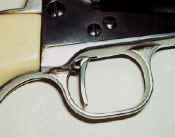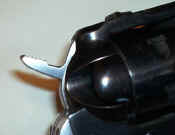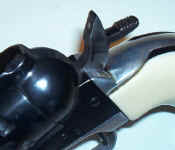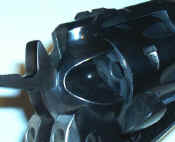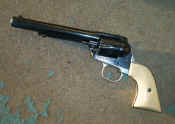The Family Gun
Jim Taylor
Back in the 1900's when there were still some Constitutional liberties being practiced, my Dad walked into a hardware store one day and walked out a bit later with a brand new Ruger Single Six. He did not have to fill out any paperwork or sign any documents. (I relate this for you younger ones who may believe such stories to just be myths. It actually used to be that way, back when we were still mostly a free country.) He gave the man cash. The owner gave him the gun and asked if he wanted a receipt. He said "No, thanks." and took his new gun and departed. As it should be.
Ruger
made only one Single Six in those days. It was sort of fixed sights ( the rear sight was adjustable for windage by moving it in the dovetail using a brass
drift) and in .22 rimfire. In those days .22 Shorts were the cheapest way
to shoot and Dad had a car load of them and planned on using the Ruger with
them. Taking the gun to a range he sighted it in, but found it would not
group. Mostly it shot patterns. No matter what ammo he tried.
rear sight was adjustable for windage by moving it in the dovetail using a brass
drift) and in .22 rimfire. In those days .22 Shorts were the cheapest way
to shoot and Dad had a car load of them and planned on using the Ruger with
them. Taking the gun to a range he sighted it in, but found it would not
group. Mostly it shot patterns. No matter what ammo he tried.
Checking the gun over he could not find what was wrong, so at home he slugged the bore. The rear of the barrel seemed to feel funny, and eventually he discovered that the rifling broach had not rifled the first 2" of the bore... it had scratched some lines in it but the rifling was distorted and basically non-existent. He called Ruger and they said they would replace the barrel at no charge if he would send them the gun.
Never one to act hastily, Dad mulled this over a few days and decided to decline Ruger's offer. Instead he decided to rebarrel it for himself. He had a Model 52 Winchester target rifle barrel that had only 50 rounds put through it before it was pulled off the gun. The Model 52 would only shoot 1 1/2" at 100 yards and Dad's cousin who liked to shoot Smallbore Benchrest was disgusted with it. He rebarreled the rifle with a new Winchester barrel and gave the old one to Dad. (It turned out to have a chamber slightly out of line with the bore.) Dad figured he would use the barrel for the Ruger.
In
the machine shop he cut a piece long enough to make a 6 1/2" barrel, turned
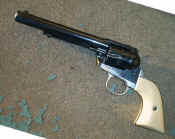 threads on it so it would mate with the Ruger frame, and put it into the gun.
He fitted it with a tight barrel/cylinder gap. While he was working on it
he straightened the trigger, lightened the hammer to speed the fall, and
rechambered one chamber to .22 Magnum. Carried with the hammer down on an
empty chamber the Magnum chamber is the perfect one to do it on. Keep a
few Magnums in your pocket for long shots or bigger targets and you are set.
Dad numbered the chambers and marked the Magnum chamber with a bevel so it could
easily be seen. The trigger pull was set at about 10 ounces.
threads on it so it would mate with the Ruger frame, and put it into the gun.
He fitted it with a tight barrel/cylinder gap. While he was working on it
he straightened the trigger, lightened the hammer to speed the fall, and
rechambered one chamber to .22 Magnum. Carried with the hammer down on an
empty chamber the Magnum chamber is the perfect one to do it on. Keep a
few Magnums in your pocket for long shots or bigger targets and you are set.
Dad numbered the chambers and marked the Magnum chamber with a bevel so it could
easily be seen. The trigger pull was set at about 10 ounces.
On the range this gun proved to be extremely accurate.... with almost any kind of ammo. Dad mostly shot Shorts in it during the 60's and into the 70's... but then they became more expensive and so the practice was stopped. I personally witnessed him - shooting from a sitting position, resting his arms on his upraised knees, his back supported by leaning against the car tire - keep 15 out of 20 shots on the end of a beer can at 80 yards... using Shorts. He took a lot of rabbits and small game with it over the years and used it at least one time to successfully defend himself against some young punks who thought they were going to run him off the road.
Some years ago Dad came to me and said he wanted me to have the gun. We talked it over and I accepted. It was an honor to do so. I carried it around the high Sonoran desert country of Arizona for about 12 years before we moved to Missouri. I shot coyotes, foxes, skunks, dogs, cats, rabbits, snakes of various types and one Mule Deer with it.
The
Mule Deer shooting happened this way:
I had filled my tags earlier in the week and was taking several friends hunting
who had not killed a deer yet. I carried the .22 Single Six with me for personal
use and it had come in handy earlier in the day. Coming up over a rock
ledge I met huge diamondback rattlesnake face to face. It was coiled up on the
ledge above me and as I came up it reared it's head up. Without thinking I
jerked the .22 and shot it in the head. Thicker than my arm, the snake was
so long that when I held it up above my head it's tail drug the ground... it was
near 6 foot long!
I had sent the two hunters around some canyons and while I was going the other way I heard 4 shots off in the distance. I decided to head over there and see who it was. As I worked my way toward where I heard the shots I noticed someone standing on a hill and waving his arms. Getting in closer I recognized the man. He signaled to me that the deer was down below him and in front of me. I gathered he had wounded it and that his gun was empty!
I worked my way into where he was pointing, taking my time. As I came up near a small brushy wash the Mule Deer made a bid to get away from me. As it went past me I put the sights on it's head and shot it between the base of the antler and eye with a .22 Magnum HP. The deer jerked, stiffened and turned away from me, dragging it's hindquarters. I put the next shot, a Winchester .22 HP, right into the middle of the back of it's head. At that one the buck dropped.
Turned out the hunter had been sleeping under a Mesquite tree and woke up to find some deer around him. He panicked and started firing, missing a couple shots but breaking the pelvis of the buck with his last bullet. He had no more ammo with him and until I showed up was considering trying to jump the buck and kill it with his knife. (Which I would have liked to seen, but would not have been a smart move on his part.)
My first shot with the Magnum round went under the brain pan.. through the sinus cavities apparently. But the .22 did a good job never-the-less, in spite of my poor shooting.
Over the years we fired hundreds of thousands of rounds through the gun. And over the years it began to loosen up. Yes, even a .22 will develop end-shake. Every time you fire a revolver, the cylinder sets back and rocks upward, ever so minutely. The metal-to-metal contact, even in thousandths, gradually will get larger. It took over 30 years of constant use and hundreds of thousands of rounds of ammo, but eventually the cylinder gap became larger and the gun began to "spit". By this time the finish was long gone. In 1994 I decided it was time and sent the old pistol down to Hamilton Bowen at Bowen Classic Arms for rebuilding.
Hamilton set the barrel back one thread, cut a new throat, and removed all the endshake from the cylinder by installing a new bushing on the cylinder and refitting it. Then he polished and reblued the gun. When I got it back it looked better than it did when it was new!
And it is still accurate! More so than I can shoot it most times.
This gun is a treasure that will stay in the family. One of these days I will call one of my kids and say, "I have something to give you." They will get the gun along with this story. Hopefully it will be passed from generation to generation... no matter what the rest of the world does.
